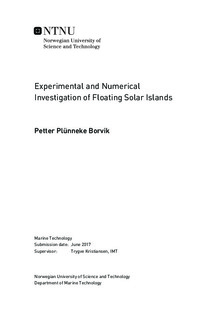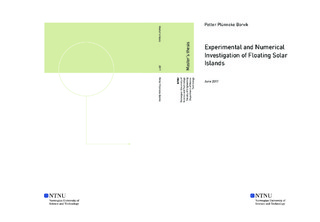| dc.description.abstract | In this master thesis, the dynamical behavior of a floating solar island in waves and current has been investigated. The solar island consists of a torus were the inner part is covered with a membrane. Underneath the membrane an overpressure is applied to support the weight of the photovoltaics panels. A skirt is hanging from the side to prevent leakage of the pressure. This thesis will not go into detail where all the possible placements of the island are, but one alternative is at the coast outside West Africa.
The investigation has been done through model testing. Two different configurations of the solar island were investigated; a model made with an elastic torus and a model with a rigid torus. The other parts of the model were equal. The models are compared in regular waves with height-to-wave length ratio 1/30 and wave period between 0.6-1.6 s, regular waves and current and irregular waves.
A numerical model for the heave response has been developed based on the theory for a floating torus and a surface effect ship, by use of linear potential flow theory. The experimental results are in good agreement with the numerical result. The membrane will lead to larger vertical motion for small wave frequencies and a reduction of the response for high wave frequencies. Another effect of the membrane is that the vertical acceleration and force in the mooring lines gets increased. The largest difference between the two models are the global behavior, since the elastic model is able to follow the waves.
Out of water and over-topping of waves were observed. These non-linear phenomena can lead to flooding of the island. Flooding for both models were observed in; regular waves with steepness 1/20 and period T = 12.1 s and irregular waves with peak period Tp > 12.0 s and significant wave height, Hs > 5 m.
Further investigation of the solar island is needed to include the effect of the membrane and skirt in the numerical model of the response in horizontal and vertical direction. | |

